The Goldilocks Equation: How to Get Things "Just Right" |
People get pretty darn excited when things go their way. Nothing proves this more than the proliferation of colorful expressions used to describe this phenomenon, such as "hitting the sweet spot," or being "on a roll," "in the zone," "on the ball," "right on the money," or "in the groove." Finding your way into "the zone" is dependent upon a number of variables that are summed up by what I like to call the Goldilocks Equation, named after the famous fable of yore. The Goldilocks Equation states that too little is not enough, too much is more than you need, and that somewhere in between, things are "just right." It is an elegant equation, quite simple in theory, but often preposterously difficult in execution.
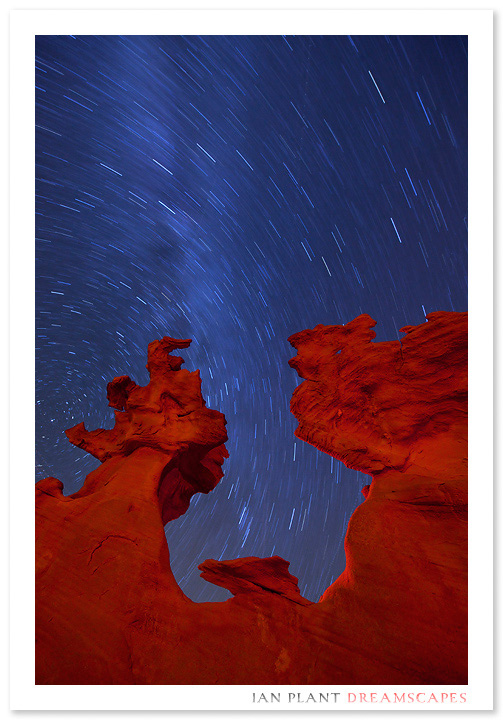
"Gates of Heaven" Hobgoblins' Playground, Nevada.
For those who have never heard of Goldilocks, here's a brief summary: Goldilocks, our footloose and fancy-free protagonist, wanders through the woods one day and stumbles upon a nice house owned by three bears, who are away working their day jobs to keep up with their wildly fluctuating adjustable-rate mortgage. Goldilocks, who just completed a stint in maximum security for breaking and entering, lets herself in. She eats the bears' porridge, sits in their chairs, and lies in their beds. Each time, she tries three different variations until she finds the one she likes best: for example, the first bowl of porridge is too hot, the second too cold, and the final one is (you guessed it) "just right." When the bears come home and catch her in the act, they decide that Goldilocks would taste better than porridge, and eat her (because that's how bears resolve interpersonal conflict).
Okay, maybe I took a bit of creative license with the story, but nonetheless, at this point the intrepid reader might ask: What does this have to do with nature photography? And what the heck is porridge? Although I can't answer the second question, I can offer an answer to the first: experimentation is the key to finding that "just right" photograph. After all, without experimentation, how else can you know whether you have too much, too little, of just enough?
Varying an image's composition is probably the most basic application of the Goldilocks Equation. An early mentor of mine once described photography as an iterative process, and recommended "working through a scene," gradually trying different compositions and variations as one progresses through the various elements of a scene. For example, you start with a wide angle lens, a clump of flowers in the foreground, and a mountain in the background. You move left, you move right, you exclude the flowers, you fill the frame with them, you change lenses, you back up, and so on, until you find an image that really works. While sometimes the shot is obvious, more often than not, one has to experiment a bit - or even a lot - before finding an image that stands above the rest.
For example, with the image below, I spent a fair amount of time using a long telephoto lens to isolate individual cascades surrounded by reflections, but the resulting images weren't really doing it for me. When I went to the other extreme - wide angle - the resulting images seemed too cluttered and less coherent. As it turned out, somewhere in the middle proved to be "just right." Using a mid-range focal length, I found a perspective that allowed me to exclude non-essential parts of the scene, while including the sweeping curve of the rapids and the rocks, creating more compositional power than my previous iterations. Only by trying all of my options, and "working the scene" as thoroughly as possible, was I able to successfully apply the Goldilocks Equation.
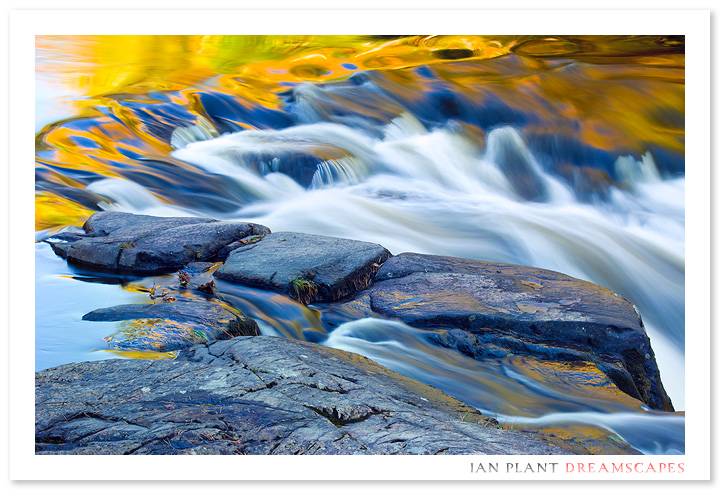
"Ausable Reflections" Adirondack State Park, New York
Another way to work a scene is to experiment with light. This typically means staying at a location for an extended period of time to wait for the light to change, or to return to a scene at different times of the day, week, month, or even year. Try front lighting, side lighting, and back lighting to see how each works; also try sunset, sunrise, twilight, overcast, and even middle of the day. Wait for that "just right" moment to make a scene come alive.
After first scouting the location of the image below, I returned several times during different types of light to find something that would work. Warm sunrise light on the sandstone lines proved to be too much, overpowering and merging the weak pastel colors. Overcast light proved to be too little, leaving the scene drab and without contrast or color. Then, one morning during twilight, clouds in the sky lit up, bathing the scene in soft pink. The reflected glow from the clouds added contrast and color to the foreground, while the background clouds reinforced the shapes in the sandstone. Finally, patience, persistence, and most important - variation - had paid off.
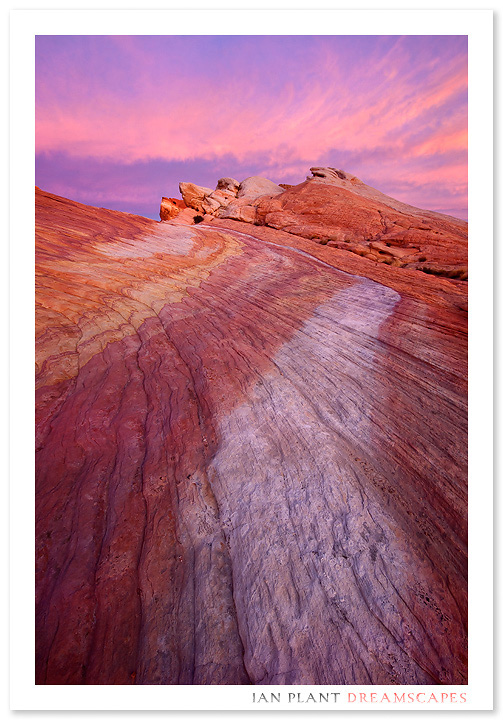
"Road to Perdition" Valley of Fire, Nevada
The great thing about digital photography is that you can take as many variations of a scene as you want without cost or penalty (assuming, of course, you have enough memory cards with you). Furthermore, the "digital darkroom" gives you many options that might not otherwise be easily available. With the image below, a weak sunset just wasn't giving me the magic I had hoped for: the diffused light didn't have much color, and I wasn't able to return to the scene again for a second (or third or fourth) chance. But I really liked the composition, and I felt that if I could just find the right variation, I'd have something successful. It was then I realized that black and white treatment would be perfect for this image. Sure enough, by staying flexible and exploring all of my options, I found something that worked.
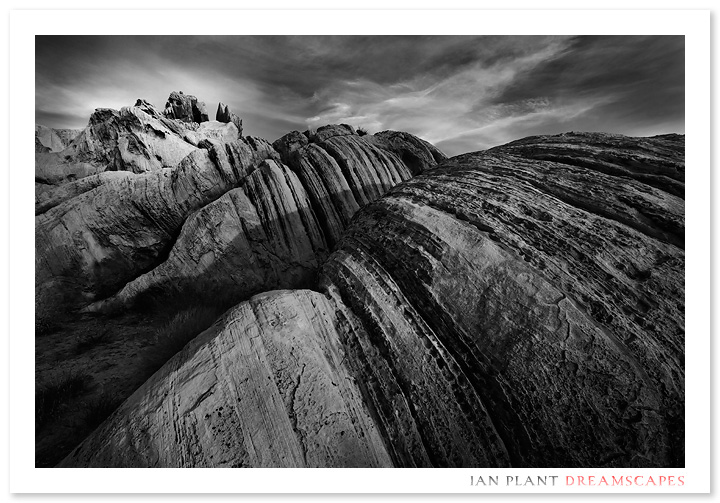
"Ancient Mounds" Whitney Pocket, Nevada
Variation can also be achieved with the tools in your camera bag. While hiking Zion's famous Narrows of the Virgin River, I chanced upon a scene of remarkable beauty. A sun-lit mountain and blue skies reflected in the water at my feet, while the canyon walls glowed with orange light. After selecting my composition, I placed a polarizer filter on my lens. Turned to full polarization, I was able to remove distracting glare from the water and the wet canyon walls, but I lost the reflections in the foreground. Too much. With no polarization, I was able to retain the foreground reflection, but the glare remained everywhere else, robbing much of the scene of its full color potential. Too little. Somewhere in the middle of these two extremes, I found the right balance between glare removal and reflection retention, and suddenly a dizzying array of color seemed to explode from the viewfinder.
Just right. Goldilocks, you couldn't have said it any better.
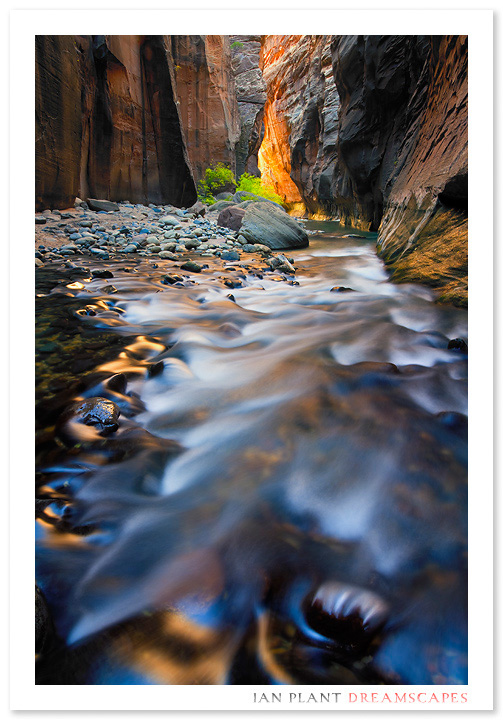
"Canyon Kaleidoscope" Zion National Park, Utah
Comments on NPN landscape photography articles? Send them to the editor. NPN members may also log in and leave their comments below.
NPN Contributing Editor Ian Plant is a full-time professional nature photographer, writer, and instructor. His images and instructional articles have appeared in a number of books, calendars, and magazines including Outdoor Photographer, Popular Photography, National Parks, Blue Ridge Country, Adirondack Life, Wonderful West Virginia, and Chesapeake Life, among others. Ian is the author/photographer of eight books, including the critically acclaimed Chesapeake: Bay of Light. Most recently, Ian was one of the lead authors and executive editors for The Ultimate Guide to Digital Nature Photography, and co-author of 50 Amazing Things You Must See and Do in the Greater D.C. Area. Ian is co-owner of Mountain Trail Press and Mountain Trail Photo, and he leads several photography workshops every year.
To see more of Ian's work, visit Ian Plant Photography and Mountain Trail Photo. The Mountain Trail Photo Team consists of some of the top nature photographers in the country, whose mission is to educate and inspire others in the art of nature photography. There you will find team member images; articles on photo techniques and destinations; and information on workshops in some of America's most beautiful places. Also visit the Team's Blog for a more eclectic mix of images and musings.